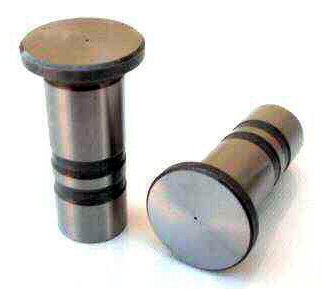Reason for my question:
There is an intermediate step (not "green", and no longer favored as an advantage) that has been used for 75 years - the mushroom tappet.
The maximum velocity a flat tappet can reach (which determines how much valve open area you can fit into a specified duration) is roughly proportionate to the tappet's contact surface length:
Maximum velocity per degree Of rotation = (tappet diameter - .040”)/114.6so the .904" and .875" are favored over the .842" for V8 because they allow hotter profiles.
For many V8s this has limits because the tappets are so close together, but it appears that the stovebolt & GMC spacing is more generous.
There is no complex machining, because the gallery appears fairly open and only clearance to permit the upper (non-critical) surface of the "foot" to rise farther.
The cam can be any cam that works as to material (no steel, billet, etc.), but the grinds can be far more aggressive, especially the "split" between nominal IVC vs. effective (.050") IVC (which balances compression bleed-down against inertia fill), and nominal EVO vs. effective EVO (which balances pumping loss against duty cycle %).
How about the tappet price?
Just use the VW Type I (air-cooled opposed 4) 31mm (1.22", over 24% more area than a .990" stock tappet) mushroom, still made new & cheap by EMPI, by bushing the tappet opening down to .748" (19mm). The tappet still rotates as normal with the tapered lobe.
No linkage, no tie bars.



